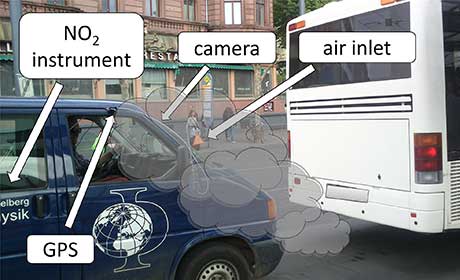New Device Measures Nitrogen Dioxides In Exhaust from Preceding Vehicle
22 December 2015

Depending on its age, condition and even engine, how much does an individual vehicle pollute the urban air? Researchers from Heidelberg University are looking into the matter. The team led by environmental physicist Dr. Denis Pöhler has developed an innovative device that can measure nitrogen dioxides in the exhaust of the preceding vehicle. This spectroscopic instrument delivers reliable emission values under actual driving conditions, measurements that were formerly possible only with expensive systems attached directly to the vehicle. Rather than insufficient model calculations, the data collected via the mobile device can be used to identify major polluters, according to Dr. Pöhler.
Nitrogen oxide (NOx) emissions from vehicles are a major source of poor air quality in cities. In particular, the high concentrations of nitrogen dioxide (NO2) pose a problem. NOx emissions vary widely from car to car and depend on numerous parameters, not all of which are really well understood, Pöhler explains. Vehicle and engine type, exhaust gas treatment, age, condition and vehicle properties are just a few. The data authorities and researchers need for model calculations to estimate the NOx emissions of various vehicles and determine their contribution to air pollution poses yet another problem. Not only reliable emissions data under real- driving conditions required, but also studies on the actual kilometres driven for various model types. “However in their current state both datasets are extremely inadequate or very difficult to collect”, explains Pöhler. As an example, he cites some major discrepancies between exhaust values collected using a chassis dynamometer versus the actual emissions under real driving conditions.
To address the "data problem” Dr. Pöhler and his team developed an easy-to-use mobile device to measure nitrogen dioxide; they call it the “NO2 ICAD”. It uses spectroscopic absorption of molecules to precisely measure the NO2. “This instrument is therefore not sensitive to disturbances such as intensity fluctuations due to changes in temperature or vibrations. Neither other gases and particles affect the measurements”, explains Pöhler. For testing, the instrument is installed in an automobile such that the NO2concentration in the exhaust plumes of passenger cars, buses, trucks and motorcycles can be measured during travel.
In the practical test, “NO2 ICAD” was used to conduct measurements in Mainz. The city commissioned the test to be performed over seven days in March and April 2014. The Heidelberg researchers from the Institute of Environmental Physics recorded more than 730 vehicles in under real driving conditions. They identified the parts per billion (ppb) of NO2 in the given exhaust plume and compared this value with the so-called background concentration of nitrogen dioxide. This allowed them to draw conclusions about the emissions of the individual vehicles.
“In this practical test, we were able to measure nitrogen dioxide values of a few parts per billion, up to 7000 ppb. Not only differences between the vehicle categories, as expected, but even within the categories themselves were observed”, explains Pöhler. Only 7.6 percent of all vehicles exceeded the 500 ppb NO2- value, especially older buses, but also individual cars and motorbikes. “According to our data analysis, they make up 45 percent of total emissions. This means that technical upgrade or exchange on just a handful of vehicles could cut total emissions by nearly half”, continues the Heidelberg physicist. “Our measurement data also revealed the weaknesses in simulations in which certain parameters and factors such as vehicle count, fleet and emission values are not representative in the analysis.” New studies are currently being done in a number of cities in Germany.
Dr. Pöhler plans to develop a commercially viable version of his new device for measuring nitrogen dioxide in the air. The system will currently be expanded for measuring nitrogen monoxide (NO) and carbon dioxide (CO2), thus supporting a number of different environmental observations and emission measurements. Areas of application range from high-end research, vehicle emissions measurement, air quality monitoring, as well as applications in industry and medicine.

